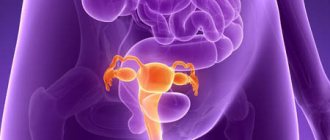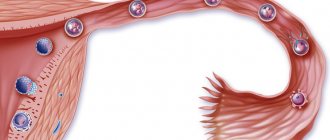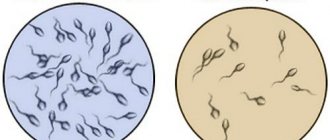The female reproductive system is aimed at procreation, and it is impossible to predict who will be born, a girl or a boy. It is believed that the sex of the child depends on which ovary ovulation occurred in. Theoretically, when the egg is released from the right appendage, girls are more often born, and boys are born from the left. Is it so? And why is the ovary so “troubled” after conception?
Why does the ovary through which fertilization occurred hurt?
Pain in the ovaries in early pregnancy is caused by psychological reasons and physiological changes occurring in the woman’s body. The functioning of the reproductive system changes. In rare cases, discomfort is due to pathology. Often the ovary is disturbed due to incorrect body position during night sleep or under pressure from the growing uterus.
Mild pain 4-7 days after ovulation and possible fertilization indicates that conception has occurred and the zygote is being introduced into the uterine cavity. Sometimes the discomfort is accompanied by light pink bloody discharge. In order not to miss the pathology, if pain appears in the lower abdomen, it is better to consult a gynecologist.
Pain in the ovary in the first trimester indicates a sprain of the ligaments that support the uterus. Unpleasant sensations intensify after physical activity, making sudden movements, or staying in one position. In the third trimester, the discomfort disappears. Stitching or nagging pain may be a sign of psychological discomfort.
Often, pain in the ovaries after conception occurs in women who have gone through in vitro fertilization. This is due to the body's response to hormonal stimulation. Patients suffering from polycystic ovary syndrome are susceptible to this unpleasant symptom. There are also pathological causes of discomfort, but they are rare.
Is it possible to change the gender of a child at conception? - Helpful information
Many couples, when deciding to conceive their first child, do not bother themselves with the thought of what gender the baby will be. The main thing is to be born healthy! But when a second or subsequent pregnancies are planned, the parents' preferences become more clear. For example, if there is already a boy in the family, the couple wants a girl, or vice versa. And then the big question arises: is there a chance of becoming pregnant with a child of a certain gender?
The Internet is full of information about diets and positions that can help conceive a boy or girl; some women trust tables and calendars in the hope that in such and such a month, at such and such an age, they will be able to become pregnant with a child of the desired sex. But the authors of articles that provide such information warn: you should not hope that the recommendations will “work,” because no one can guarantee a 100% result.
Science has proven that the sex of the baby is programmed at the moment of conception. The fact is that both men and women have two chromosomes. In men there is a Y chromosome and an X chromosome, in women there are 2 X chromosomes. It is the male chromosome, whether X or Y produces fertilization, that determines the sex of the child.
The body of any healthy woman is designed in such a way that conception can occur only on certain days of the month. As you know, a woman’s menstrual cycle has a strictly individual period, it ranges from 25 to 35 days.
Around the middle of the cycle, ovulation occurs, that is, the release of an egg from the ovary. The egg then travels into the fallopian tubes and then into the uterus. She is ready for fertilization in about 12 hours. If this does not happen, the egg will die.
It is important to know! Sperm with a Y chromosome (called male) move faster than sperm with an X chromosome (female). Although male cells reach their target (eggs) faster, they also die faster. Female cells are slower in this regard, but tenacious.
What do experts think about this?
Obstetrician-gynecologist of the 1st City Clinical Hospital Marina Gennadievna VIRSHICH:
— You shouldn’t trust calendars and tables blindly. Each person’s body is individual, it cannot be adjusted to any general data, although, of course, there are coincidences. It is known for sure that the man and his sperm are responsible for the sex of the child. Or rather, the sperm that will be faster and will give its chromosome to the egg: X (responsible for a girl) or Y (responsible for a boy). In order for a man’s sperm to be active and healthy, it is important that it does not stagnate. This requires regular sex life.
It is worth knowing that a sperm lives 72 hours, an egg lives 48. That is, on the day of ovulation you are more likely to become pregnant with a boy. A couple of days before ovulation - a girl. How to find out the exact time of the cherished day? For example, a common way is to do ovulation tests (sold in pharmacies).
Another, no less popular way: to monitor the onset of ovulation using ultrasound. How does this happen? An ultrasound is done in the middle of the cycle, from days 10 to 14. During the examination, the doctor looks at the ovaries to see if there is a dominant follicle in which the egg matures.
The woman goes for an ultrasound several times, the doctor monitors the growth of the follicle during diagnosis, and when it grows to a certain size, the patient is informed: ovulation has occurred, this is evidenced by the fact that there is no follicle, and in its place is the corpus luteum of the ovary. The favorable period for conception has arrived! Some say that if ovulation occurs in the left ovary, then there will be a boy, if the egg matures in the right ovary, then expect a girl.
Medical obstetrician-gynecologist Natalya Vladimirovna CHEREVKO:
— There is a lot of information about ways to influence the sex of a child during conception. For example, follow a certain diet on the eve of ovulation, etc. Also, some determine the best time for conception using Chinese calendars, where the probability of having a boy or girl at a woman’s age is calculated.
On what basis were these conclusions made? There is no particular scientific research involved here, other than statistical research. Those. specifically, a certain period of time was taken: a certain number of women, the gender of the children born to them, and an analysis was carried out. These data are statistical conclusions. There is a chance of a coincidence, but what will it be? Nobody can tell.
Ovulation issue. There is evidence that if conception occurs on the day of ovulation, more boys are born. If from a day to three days after, the likelihood of having a girl is higher.
My personal opinion: don't bother with this. The main thing is that the child is healthy. After all, it also happens that, due to the individual characteristics of a man, his sperm do not carry the gene responsible, for example, for a boy. If he gets two X's, then no matter how hard he tries, he will still have a girl. One more thing, for a woman who is very fixated on conceiving a child of a certain gender... If, according to the results of an ultrasound, she does not get the gender that she and her husband expect, even the following reaction happens... The woman throws up a scandal: “I will not give birth to this child, I do not need him". And throughout her pregnancy she carries the baby in this depressive state. It has been scientifically proven that this will subsequently have a negative impact on the child, because he is not wanted, he is carried as unwanted.
That's why I always say: as God willing. After all, one should, in principle, rejoice at the child, because not everyone is given the opportunity to have one...
There are women who believe that IVF will help with a 100% guarantee of getting a child of a certain gender. It's a delusion. Currently, according to the law, two embryos are transferred during IVF. Because a multiple pregnancy, for example, triplets, is fraught with very serious complications, both for the mother and for the children. Especially for a mother who finds it difficult to bear... And it is unknown which of these two embryos will take root: “boy” embryos are more fragile and delicate, while “girl” embryos are more tenacious and hardy.
My opinion is that desperate people go to IVF, whose question is specifically about the possibility of conception. And here we shouldn’t worry: we want a boy or a girl. And you just have to hope that the embryos will take root, that there will be a positive result. Women who have undergone IVF, and especially more than once, need to have monuments erected: because it is an insane and difficult many-month, and for some, many years of work: it is constant stress, constant medical manipulations. These women can say for sure: it doesn’t matter what gender the child will be, the main thing is that it will be there! Healthy and happy!
Sexologist Yuri Nikolaevich Zharkov:
— Family planning has always been relevant. People always wanted to know in advance who would be born: a boy or a girl in a couple. As always, all information in the social world can be divided into two parts: that information that belongs to culture, and that that belongs to science. What to do to have a boy or a girl has been known in culture for a long time. It was believed that if you hold an ax under your pillow on your wedding night, then a boy will be born.
If a woman often eats black crusts of bread, then a boy will be born. There are methods: blood renewal method, calendar method, Chinese calendar, Japanese calendar, etc. These methods are simple and, to put it mildly, not very effective.
A theory has been developed, based on scientific evidence, that there is indeed a process in nature that, in advance of conception, increases the likelihood of conceiving either boys or girls. A man and a woman can easily achieve this result, i.e. conceiving a boy or girl if they change the rhythm of sexual activity approximately 2.5-3 months before the moment of conception. A woman needs to control her cycle and know the exact day of ovulation. Together with your husband, decide how often sexual activity will occur. This is individual for each couple.
There’s a twist to this: after all, couples live differently: for some, 3 times a week is a normal rhythm, for others it’s frequent, and for others it’s rare. Therefore, here a nuance arises; sometimes a couple will need to consult a sexologist. But we can say that if sexual intercourse is regular, then the likelihood of conceiving a boy increases significantly! And if periods of abstinence are frequent: once every ten days, for example, at such intervals, then there is a high probability of conceiving a girl.
This is in general, but there may be nuances. This is due to the peculiarities of the constitution of the human body, because in the male body there are different conditions for life activity and the formation of germ cells. These conditions are associated with hormonal provision, with the transport of germ cells, and with the general state of health. All these factors can influence the properties of sperm that they acquire at the time of maturation. As a result, if the rhythm of sexual life is frequent, then the sperm that carry the X chromosome turn out to be less stable and less competitive.
There is scientific evidence that even the number of such sperm decreases during ejaculation, and the number of sperm carrying the Y chromosome increases... The fact remains: frequent sexual activity changes the properties of sperm, and preferential fertilization increases. Because those sperm that carry the Y chromosome pass through the woman’s cervical canal more easily, receive more advantages for fertilizing the egg. As a result, the boy develops. Conversely, if this is abstinence, then sperm carrying the X chromosome receive advantages during fertilization. The girl is developing. These are statistical models that work in the interests of adaptation, the meaning of this phenomenon is that it has biological expediency in the interests of the entire human world.
Liked? Tell your friends!
Home All list of materials
Gestation period
Throughout the gestation period, progesterone levels constantly increase, which requires an increase in VT activity.
Until 12 weeks of pregnancy, the production of this hormone occurs only in the corpus luteum; after this period, the placenta takes over the endocrine function. By 16-20 weeks, the latter is considered fully formed, as a result of which the need for VT disappears. The gland gradually undergoes regression. After the disappearance of the corpus luteum, a scar remains on the surface of the right ovary, which is called the white body.
Probable pathologies
There is a risk of developing abnormalities in the functioning of the appendages during pregnancy. The likelihood of their occurrence increases in the presence of the following factors:
- bad habits;
- hormonal disbalance;
- the presence of chronic diseases of the genital organs;
- taking hormonal drugs without a doctor’s prescription;
- history of miscarriages and abortions;
- unfavorable environmental conditions.
With a high probability, pathologies of the luteal body occur with disease of the right ovary. During pregnancy, there are two main types of abnormalities in its functioning:
- Failure. If the VT size is less than 15 mm, its low functionality is diagnosed. A low concentration of progesterone in the blood is dangerous for spontaneous miscarriage. The woman is prescribed progesterone-containing drugs, which must be taken until 12-18 weeks of gestation.
- Cyst. The corpus luteum of the right ovary measuring 30 mm or more is considered a cyst. In this state, its functionality is impaired. After diagnosing the hormonal levels, the woman is prescribed medications to correct them. The corpus luteum cyst of the right ovary itself does not threaten pregnancy, but requires special medical supervision.
- Before any treatment, a woman needs an examination. She needs to undergo a pelvic ultrasound and a blood test to assess her hormonal levels. If there are deviations, medications that do not harm the fetus are prescribed.
Ovarian tumors in girls
The choice of medical tactics is determined by the type of neoplasia, the dynamics of its development, and the likelihood of complications. In girls with retention cysts, conservative therapy is possible. When an asymptomatic cyst measuring up to 80 mm is detected, dynamic ultrasound monitoring is recommended. Hormone therapy is used if a teenager has a long-term or recurrent functional ovarian cyst, a persistent follicle measuring more than 20 mm. Menstruating patients are usually prescribed progestins in the second half of the cycle. Since a functional cyst can develop against an inflammatory background, trial anti-inflammatory therapy is allowed. The effectiveness of drug treatment is assessed after 3-4 months from its start; if there are no results, laparoscopic cystectomy is performed, or less commonly, wedge resection of the ovary.
The detection of a true ovarian tumor in a girl is a direct indication for immediate elective surgery. The volume of intervention depends on the characteristics of the tumor process. In the presence of benign neoplasia, surgical treatment should be as gentle as possible; in the presence of malignancy, it is important to ensure maximum removal of tissues involved in tumorigenesis. The following types of operations are performed for children and adolescents with ovarian neoplasms:
- Organ-preserving interventions
. Laparoscopic enucleation is carried out for smooth-walled serous cystomas and dermoid cysts. Wedge resection is indicated for ovarian endometriosis and some confirmed benign tumors of epithelial origin. The operation is recommended to be carried out in specialized hospitals with rapid histological diagnosis and transition to radical intervention when signs of malignancy are detected. - Radical operations
. Unilateral laparotomic oophorectomy is recommended for Brenner tumors, mucinous cystomas, and papillary cystic seromas. For unilateral dysgerminomas, tecomas, granulosa cell tumors, mucinous cystadenocarcinomas, the volume of surgery is increased to unilateral adnexectomy with resection of the greater omentum. Girls with malignant neoplasia undergo supravaginal amputation of the uterus and appendages with extirpation of the greater omentum.
The scope of emergency interventions for leg torsion, bleeding and other complications is determined individually. Most often, the affected ovary is completely removed. After operations for benign neoplasms, patients are recommended to undergo dynamic follow-up with ultrasound control once every 3-6 months. In the case of a malignant process, polychemotherapy is performed in the postoperative period; for common dysgerminomas, radiotherapy with irradiation of the pelvic organs and abdominal cavity is performed.
What to do when pathological processes begin?
The cyst does not affect how the gland will perform its functions. For example, if it occurs on the corpus luteum of the left ovary, this will lead to an enlargement of the unstable organ. This does not in any way affect the production of important elements, including progesterone, which is necessary for the normal course of pregnancy.
If during an ultrasound examination it was determined that the unstable gland is larger than normal, this means that we are talking about a cyst. No special treatment or removal of the tumor is required. The cyst is a tumor, but benign. There have been no cases in medicine where it degenerated and became malignant.
Representatives of the fair sex should also make love very carefully until the end of pregnancy. Careless movements during sexual intercourse can contribute to rupture of the cyst cavity. This is already very dangerous, as it can lead to infection of internal organs and provoke termination of pregnancy.
But, if you follow all the rules and doctor’s instructions, there should be no problems. However, a woman should be prepared for the fact that the enlarged corpus luteum will produce more hormones than it should. Therefore, most likely, you will have to correct your hormonal levels with medications.
Number of follicles in the left ovary
For successful fertilization, one complete egg from the left or right appendage is enough. Normally, the number of ripening follicles ranges from 4-8, and if 9 or more are observed, then this is considered a deviation, which has a name: “follicular” or “multifollicular” ovaries. If a woman has a regular monthly cycle, then the probability of pregnancy is high. However, in the absence of menstruation, polycystic disease has most likely developed and ovulation does not occur. The patient must undergo a course of treatment in order to be able to conceive a child and avoid serious complications, such as:
- hyperplasia of the uterine epithelium,
- amenorrhea,
- hormonal disorders, breakthrough uterine bleeding,
- growth of benign and malignant neoplasms.
It is believed that the right epididymis produces eggs more actively than the left. This opinion is widespread among doctors, since in the treatment of infertility and various pathologies of the reproductive system, dominant follicles were most often identified in the right ovary. Cases of ectopic pregnancy followed by removal of the right fallopian tube are much more common. However, many women with complete obstruction of the right fallopian tube have repeatedly become pregnant, which suggests that the activity of the left or right ovary depends, rather, on the genetic characteristics of each woman.











